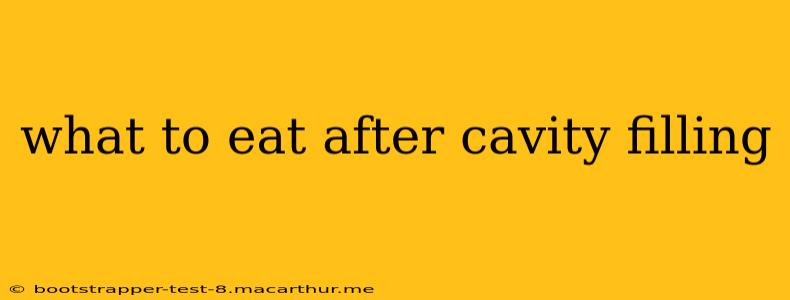What to Eat After a Cavity Filling: A Guide to Post-Procedure Nutrition
Getting a cavity filled is a common dental procedure, but knowing what to eat afterward is crucial for a smooth recovery and to protect your newly restored tooth. The immediate hours after your filling are particularly important, as your mouth needs time to adjust and the filling needs to properly set. This guide will answer all your questions about post-filling nutrition.
What should I eat immediately after a cavity filling?
For the first few hours post-procedure, it's best to stick to soft, cool foods that won't irritate the treated area or put pressure on the filling. Think yogurt, applesauce, mashed potatoes, or even well-cooked oatmeal. These foods are gentle on your teeth and gums, allowing for healing and reducing discomfort. Avoid anything crunchy, sticky, or hard for at least 24 hours.
Can I eat ice cream after a filling?
While ice cream is soft and cool, which sounds ideal, it's best to avoid it immediately after a filling. The extreme cold can cause sensitivity, and although it's soft, it's still somewhat dense and could put pressure on the newly placed filling. Stick to softer, less dense cold options initially.
What foods should I avoid after a cavity filling?
Several foods should be avoided in the hours and days following a filling. These include:
- Hard foods: Anything that requires excessive chewing, like hard candies, nuts, popcorn, and even some raw vegetables (like carrots), could damage your filling or even dislodge it.
- Sticky foods: Sticky sweets like caramel, taffy, and gummy candies can adhere to the filling and potentially pull it out.
- Chewy foods: Tough, chewy foods like bagels or jerky put extra stress on your newly restored tooth and may interfere with the healing process.
- Extremely hot foods: Hot foods can cause discomfort and sensitivity around the filling site.
- Foods that stain: Highly pigmented foods and drinks like coffee, tea, red wine, and berries can stain your new filling. While some fillings are more stain-resistant than others, it’s best to minimize your intake of these items in the days following the procedure.
How long should I avoid certain foods after a filling?
It's generally recommended to avoid hard, sticky, and chewy foods for at least 24 hours after your filling. After this time, you can gradually reintroduce them into your diet, but be mindful of your sensitivity and any discomfort. It is crucial to communicate directly with your dentist for personalized advice concerning your specific case, as recovery times may vary.
What about drinks?
Similar to food, it's best to stick to cool water or lukewarm beverages initially. Avoid very hot or extremely cold drinks, as these can exacerbate any sensitivity. Carbonated drinks should also be limited, as the acidity can potentially irritate the area.
When can I eat normally again after a dental filling?
Most people can resume their regular diet within 24-48 hours, assuming there are no complications. However, continued sensitivity is a common experience following fillings and may linger for a few days. In these cases, continuing to choose soft, cool foods is still recommended. If you experience prolonged sensitivity or any other concerns, contact your dentist immediately.
What if my filling hurts after eating?
Pain or discomfort after eating is a potential sign that the filling might be improperly placed, has a leak, or there’s an underlying issue. Contact your dentist promptly to address these concerns. Don't attempt to fix it yourself.
By following these guidelines and keeping open communication with your dentist, you can ensure a smooth recovery after your cavity filling and maintain optimal oral health. Remember, listening to your body and addressing any issues promptly is key to long-term success.
